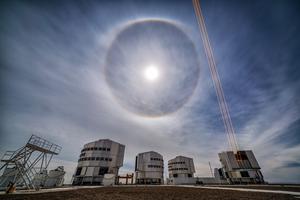Glossary term: 天文台
Description: 天文台是专门用于天文观测的场所或建筑。光学和红外观测通常使用安装在穹顶中的望远镜,这些穹顶能在恶劣天气时保护望远镜。射电望远镜和一些亚毫米望远镜则通常直接置于室外。现代地面光学、红外或亚毫米天文台通常建在山顶,以尽量减少大气层的影响。这些天文台配备了专业仪器,如望远镜、摄像机和光谱仪。而射电天文台和宇宙线观测站对高海拔位置的需求相对较小。电磁波的其他部分(伽马射线、X射线、紫外辐射和较长波长的红外辐射)可以通过专门的空间望远镜进行观测,这些空间望远镜有时也被称为天文台。不同地点的射电望远镜观测数据可以结合在一起,这些多地观测站通常统称为一个天文台。
Related Terms:
See this term in other languages
Term and definition status: The original definition of this term in English have been approved by a research astronomer and a teacher The translation of this term and its definition is still awaiting approval
The OAE Multilingual Glossary is a project of the IAU Office of Astronomy for Education (OAE) in collaboration with the IAU Office of Astronomy Outreach (OAO). The terms and definitions were chosen, written and reviewed by a collective effort from the OAE, the OAE Centers and Nodes, the OAE National Astronomy Education Coordinators (NAECs) and other volunteers. You can find a full list of credits here. All glossary terms and their definitions are released under a Creative Commons CC BY-4.0 license and should be credited to "IAU OAE".
If you notice a factual or translation error in this glossary term or definition then please get in touch.
Related Media
智利天文台总部,斯洛伐克罗伯特-巴尔萨报道
Credit: Robert Barsa/IAU OAE
License: CC-BY-4.0 Creative Commons 署名 4.0 国际 (CC BY 4.0) icons
位于帕拉纳尔天文台的欧洲南方天文台甚大望远镜与月晕
Credit: 胡安-卡洛斯-穆尼奥斯-马特奥斯/欧空局 credit link
License: CC-BY-4.0 Creative Commons 署名 4.0 国际 (CC BY 4.0) icons
凯克望远镜
License: PD Public Domain icons
哈勃太空望远镜俯瞰地球
Credit: 美国宇航局/欧空局 credit link
License: CC-BY-4.0 Creative Commons 署名 4.0 国际 (CC BY 4.0) icons
帕克斯射电望远镜
Credit: 戴维·麦克莱纳根/联邦科学与工业研究组织 credit link
License: CC-BY-3.0 Creative Commons Attribution 3.0 Unported icons













